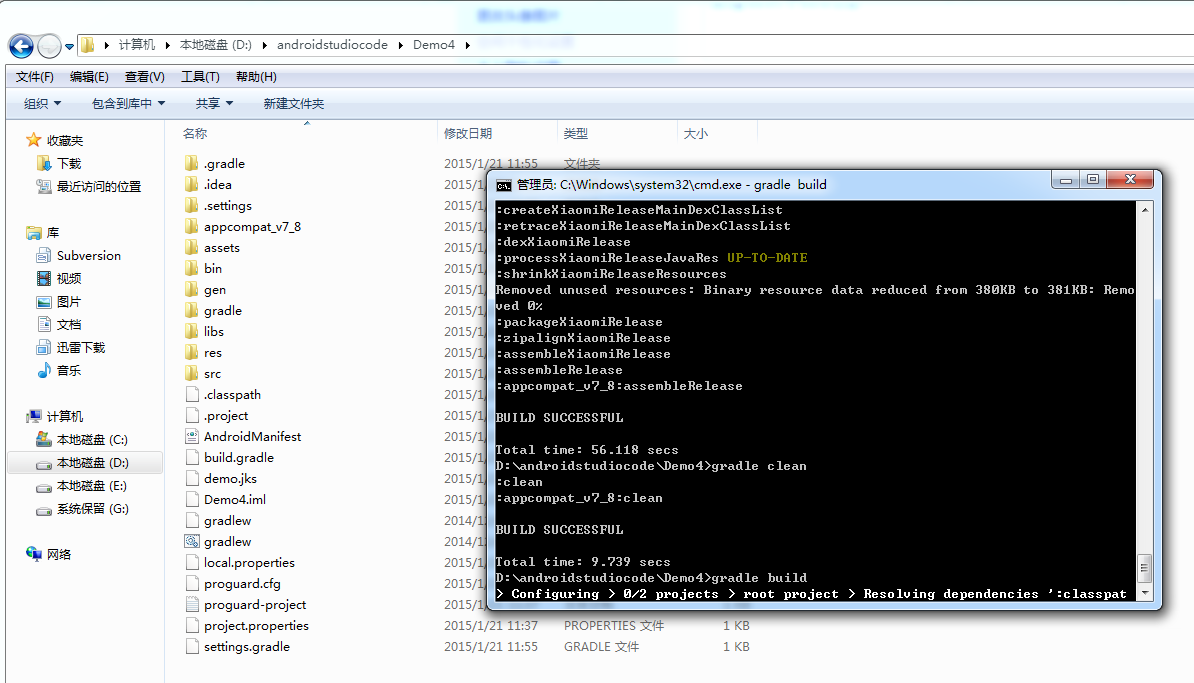Android studio 使用心得(四)—android studio 多渠道打包 这篇文章讲了一种打包方式。是直接在android studio 里面可视化操作,结合配置文件。我个人觉得严格上来讲是不完全正确的操作,因为配置文件里面的签名文件根本没有用到。但是,打出来的包绝对没问题的。这篇主要是介绍直接在dos命令里面使用gradle命令打包。两行命令,简单gradle clean ,gradle build。
1,配置文件还是和之前的一样,我才贴一次代码
|
1
2
3
4
5
6
7
8
9
10
11
12
13
14
15
16
17
18
19
20
21
22
23
24
25
26
27
28
29
30
31
32
33
34
35
36
37
38
39
40
41
42
43
44
45
46
47
48
49
50
51
52
53
54
55
56
57
58
59
60
61
62
63
64
65
66
67
68
69
70
71
72
73
74
75
76
77
78
79
80
81
82
83
84
85
86
87
88
89
90
91
92
93
94
95
96
97
98
99
100
101
102
103
104
105
106
107
108
109
110
111
112
113
114
115
116
117
118
119
120
121
122
123
124
125
126
127
128
129
|
apply plugin:
'com.android.application'
dependencies {
// <span></span>compile fileTree(dir: 'libs', include: '*.jar')
compile project(
':appcompat_v7_8'
)
}
buildscript {
repositories {
mavenCentral()
}
dependencies {
classpath
'com.android.tools.build:gradle:1.0.0'
}
}
android {
compileSdkVersion
19
buildToolsVersion
"21.0.2"
sourceSets {
main {
manifest.srcFile
'AndroidManifest.xml'
java.srcDirs = [
'src'
]
resources.srcDirs = [
'src'
]
aidl.srcDirs = [
'src'
]
renderscript.srcDirs = [
'src'
]
res.srcDirs = [
'res'
]
assets.srcDirs = [
'assets'
]
}
// Move the tests to tests/java, tests/res, etc...
instrumentTest.setRoot(
'tests'
)
// Move the build types to build-types/<type>
// For instance, build-types/debug/java, build-types/debug/AndroidManifest.xml, ...
// This moves them out of them default location under src/<type>/... which would
// conflict with src/ being used by the main source set.
// Adding new build types or product flavors should be accompanied
// by a similar customization.
debug.setRoot(
'build-types/debug'
)
release.setRoot(
'build-types/release'
)
}
defaultConfig {
applicationId
"com.example.demo4"
minSdkVersion
8
targetSdkVersion
19
versionCode
1
versionName
"1.0"
// dex突破65535的限制
multiDexEnabled true
// AndroidManifest.xml 里面UMENG_CHANNEL的value为 ${UMENG_CHANNEL_VALUE}
manifestPlaceholders = [UMENG_CHANNEL_VALUE:
"channel_name"
]
}
//执行lint检查,有任何的错误或者警告提示,都会终止构建,我们可以将其关掉。
lintOptions {
abortOnError false
}
//签名
signingConfigs {
debug {
storeFile file(
"C:/Users/xxx/.android/debug.keystore"
)
}
relealse {
//这样写就得把demo.jk文件放在项目目录
storeFile file(
"demo.jks"
)
storePassword
"demo123456"
keyAlias
"demo_4"
keyPassword
"demo123456"
}
}
buildTypes {
debug {
// 显示Log
buildConfigField
"boolean"
,
"LOG_DEBUG"
,
"true"
versionNameSuffix
"-debug"
minifyEnabled false
zipAlignEnabled false
shrinkResources false
signingConfig signingConfigs.debug
}
release {
// 不显示Log
buildConfigField
"boolean"
,
"LOG_DEBUG"
,
"false"
//混淆
minifyEnabled true
//Zipalign优化
zipAlignEnabled true
// 移除无用的resource文件
shrinkResources true
//加载默认混淆配置文件
proguardFiles getDefaultProguardFile(
'proguard-android.txt'
),
'proguard.cfg'
//签名
signingConfig signingConfigs.relealse
}
}
//渠道Flavors,我这里写了一些常用的
productFlavors {
GooglePlay {}
xiaomi {}
umeng {}
}
compileOptions {
sourceCompatibility JavaVersion.VERSION_1_7
targetCompatibility JavaVersion.VERSION_1_7
}
productFlavors.all { flavor ->
flavor.manifestPlaceholders = [UMENG_CHANNEL_VALUE: name]
}
applicationVariants.all { variant ->
variant.outputs.
each
{ output ->
def
outputFile = output.outputFile
if
(outputFile !=
null
&& outputFile.name.endsWith(
'.apk'
)) {
def
fileName = outputFile.name.replace(
".apk"
,
"-${defaultConfig.versionName}.apk"
)
output.outputFile =
new
File(outputFile.parent, fileName)
}
}
}
}
|
2.我们直接在dos命令定位到Demo4的项目目录(如果你用的是win7,可以直接先进入到项目目录,然后在空白处,先按住shift,再点右键选择”在此处打开命令窗口”)
a,输入命令 :gradle clean
b,输入命令:gradle build 然后等待。时间会比较长
直到build successfule.细心的朋友应该会发现项目目录多了一个build文件夹。
我们打包好的apk就在里面。
大家会发现里面 debug版本,release版本都有,所以速度慢。我们一般只需要正式签名版本,所以我们在gradleclean后可以这样
输入命令:gradle assembleRelease // 这是编译并打Release的包
然后会发现时间比前面要快,而且apk文件里面只有release版本的了。
另外我们如果只想要debug版本,输入命令gradle assembleDebug //这是编译并打Debug包


























 626
626

 被折叠的 条评论
为什么被折叠?
被折叠的 条评论
为什么被折叠?








